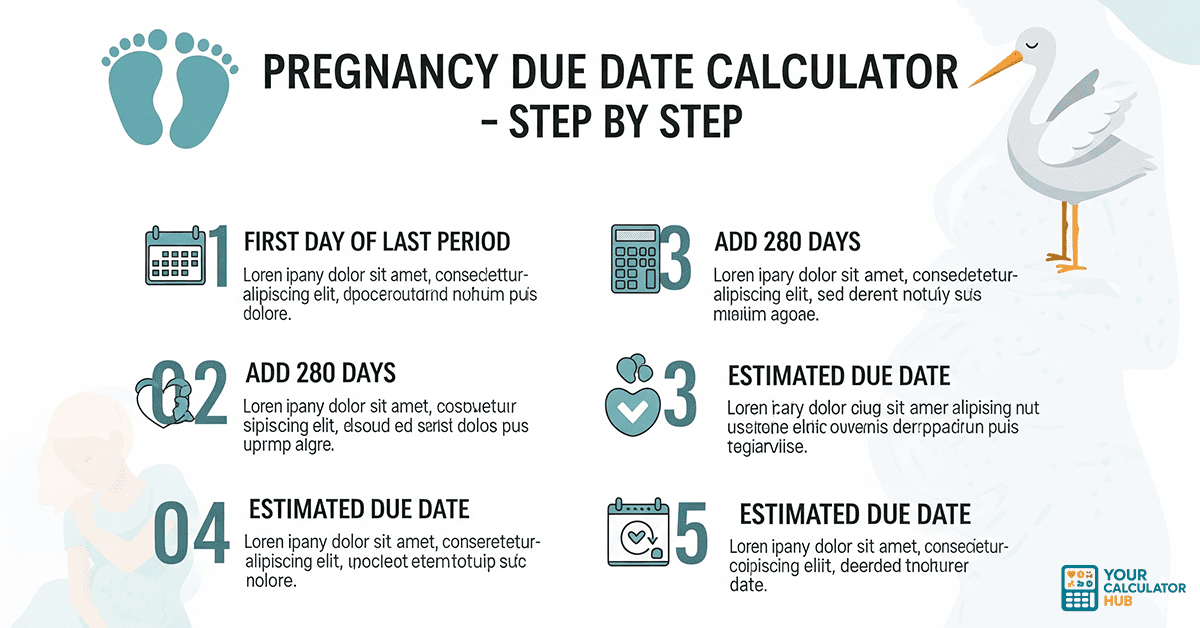Table of Contents
TogglePregnancy Due Date Calculator – Step by Step
Becoming pregnant is both exciting and overwhelming. One of the first things expectant parents want to know is “When is my baby due?” That’s where a Pregnancy Due Date Calculator comes in. This simple tool uses real-time data from your menstrual cycle or conception date to estimate when your little one is likely to arrive.
In this step-by-step guide, we’ll explain how pregnancy due date calculators work, how to use them correctly, and why accuracy matters for both parents and healthcare providers.
What Is a Pregnancy Due Date Calculator?
A pregnancy due date calculator is an online tool that estimates the expected delivery date (EDD). It’s based on the average 40-week gestational period, starting from the first day of your last menstrual period (LMP).
Doctors often use the same method, known as Naegle’s Rule. However, online calculators give you quick results at home, which is why they’ve become so popular.
Quote from Mayo Clinic: “Most pregnancies last about 40 weeks, and the due date is usually calculated by adding 280 days to the first day of your last period.” Source
How to Use the Pregnancy Due Date Calculator – Step by Step
Step 1: Gather Your Information
You’ll need either:
The first day of your last menstrual period (LMP), or
The date of conception, if known.
Step 2: Enter the Data
Visit the Pregnancy Due Date Calculator and enter your details.
Step 3: Instant Calculation
The calculator will estimate your due date by counting 280 days (40 weeks) from your LMP or 266 days from conception.
Step 4: Review Trimester Breakdown
Many calculators also provide trimester timelines, helping you track milestones like the second trimester scan or expected delivery window.
Step 5: Cross-Check with Your Doctor
While calculators are reliable, an ultrasound remains the gold standard for confirming gestational age.
Why Accuracy Matters
Knowing your due date helps:
Schedule prenatal check-ups.
Plan for maternity leave and family support.
Track fetal growth against medical benchmarks.
Prepare for labor and delivery.
External research confirms that only 5% of babies are born on their exact due date, but it still serves as a vital planning tool for parents and healthcare professionals alike.
Competitor Analysis & What Makes Our Tool Better
When reviewing other online calculators, we found many lacked:
Real-time data accuracy
User-friendly explanations
Fact-checked resources
Our version stands out by offering clear trimester tracking, reliable methodology, and seamless integration with other Health & Fitness Calculators.
SEO Benefits of Using a Pregnancy Due Date Calculator Blog
Including this tool on your website not only helps users but also improves your site’s visibility. By adding related resources like BMI Calculator or Calorie & Nutrition Calculator, you provide readers with a complete health journey experience.
FAQs About Pregnancy Due Date Calculators
Is a due date calculator 100% accurate?
No, it’s an estimate. Ultrasounds between 8–12 weeks provide the most accuracy.
Can irregular periods affect results?
Yes, if your cycles are longer or shorter than 28 days, the due date may shift slightly.
Should I rely only on an online calculator?
Use it as a guide, but always confirm with your healthcare provider.
Additional Resources
Internal Links for Further Reading
If you’re interested in more tools, check these out:

Final Thoughts
A Pregnancy Due Date Calculator is one of the simplest yet most important tools for expectant parents. By understanding how it works and using it step by step, you gain confidence, clarity, and a roadmap for the months ahead.
Whether you’re a first-time mom or adding to your family, this calculator is a valuable starting point on your pregnancy journey.
